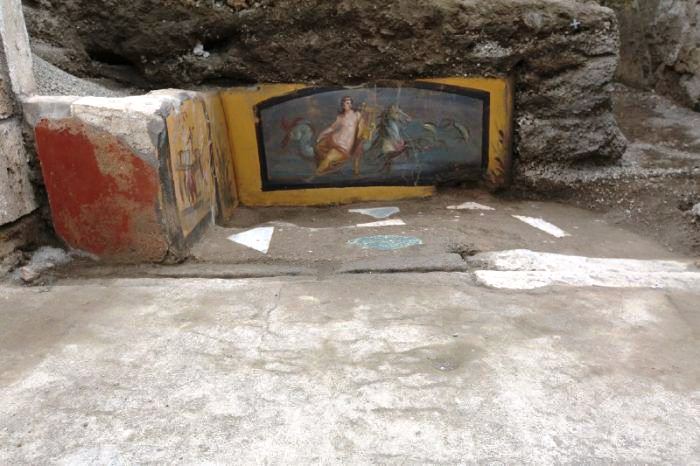Similar snack counters dug up throughout Pompeii were once destinations for on-the-go Romans looking for a quick bite.

Recently on Instagram Massimo Osanna, the outgoing director of excavations at Pompeii, posted an image of an elaborately painted thermopolium.
If you aren’t familiar with the name, it’s essentially the Roman equivalent of a fast-food restaurant.
The Guardian’s Rome correspondent Angela Giuffrida reports that the snack stand Osanna highlighted was found in Regio V, a 54-acre site north of the archaeological park that is currently being excavated. It is far from the first thermopolium to be discovered in Pompeii; over two centuries of excavation, more than 80 of the counters have been unearthed in the ruins of the city buried by the ash of Mount Vesuvius in 79 A.D.
While contemporary Americans with our food trucks, vending machines and fast food chains may think we pioneered the concept of the quick meal, the Romans were masters of going out for a bite over 2,000 years ago.
Thermopolia were found throughout the Roman world, frequented by many in the empire looking for a quick lunch. While they didn’t have a drive-thru lane for chariots, they were pretty ingenious. The snack spots were usually designed as long counters with earthware jars, called dolia, embedded in them to help hot foods and drinks stay warm.
Though some of the snack stands had a small room in the back for dining in, Áine Cain at Business Insider reports that the fare was primarily designed to be eaten on the go. Essentially, as Roman expert Stephen Dyson of the University of Buffalo tells Jennifer Viegas at Discovery News, think of them as a cross between a “Burger King and a British pub or a Spanish tapas bar.”
A significant portion of the Pompeii’s population—which experts estimate could have been as large as 20,000—frequented such places, a trend that Stephanie Butler at History.com reports is not dissimilar to the behavior of Americans consumers eating out today. Recent estimates suggest that over a quarter of the U.S. population eats fast food on any given day.
Despite or perhaps because of their ubiquity, the thermopolia had a bad reputation, Butler writes. Criminals and heavy drinkers often hung out there. It was enough of a problem that Emperor Claudius once commanded that the establishments be closed to cut down on crime.
According to a press release, the recently discovered snack counter is decorated with the figure of a Nereid, or sea nymph, on horseback in the ocean. Another image depicts business taking place at the little restaurant, and may have served as a shop sign.
“Even if structures like these are well known at Pompeii,” says Alfonsina Russo, interim director of the archaeological park, “discovering more of them, along with objects which went hand in hand with commercial and thus daily life, continue to transmit powerful emotions that transport us to those tragic moments of the eruption, which nonetheless left us unique insights into Roman civilization.”
The big question is what types of things the Romans were snacking on when they grabbed their fast food. Cain of Business Insider reports that the shops likely sold spiced wine, meats and cheese, fish, lentils, nuts as well as garum, the sauce made of fish guts that was as ubiquitous as ketchup in the ancient world. Which is to say, most Romans likely weren’t wringing their hands about how bad fast food was for them like modern burger lovers are wont to do—they were eating the Mediterranean diet even when they got takeout.